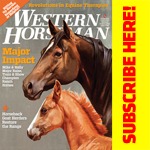This artist’s paintings and study of horse and cattle brands offer historically accurate expressions of the Southwest.
In the annals of Western artists, there are many names that for some reason seem to slip from prominence. Not that their contributions weren’t important and relevant, but rather they just weren’t “front and center” like many of the genre. One such artist that should be remembered and celebrated is the superb Western illustrator and scholar, Don Louis Perceval (1908–1979).

Photo courtesy of the Santa Barbara Historical Museum
Perceval came to his love of the West and its art form coming to the United States and California via his parents’ relocation from England where he was born. As a small child growing up near Essex, he lived surrounded by greenery, yet was fascinated by pictures and stories of arid regions and deserts. The family’s move to the United States—specifically Los Angeles, California—was the height of adventure for a small boy, and he studied everything he could about the desert Southwest and visited the Hopi and Navajo tribal areas with his parents. Initially self-taught in his artwork, Perceval was already being paid for his authentic and knowledgeable illustrations by the time he was 19.
In his early 20s he traveled back to England for more formal training, but the desert light and feel brought him to the interior of Spain, where he continued his drawing until he joined the Royal Navy to serve in World War II. After a four-year stint, he returned to California and started teaching at the Chouinard Art School (now the California Institute of the Arts), and later at the prestigious Pomona College.
During all of these life changes, Perceval continued his study of the West and its historic lore along with the relationships of Mexico and Spain where the vaquero culture of Alta California originated. One of his favorite studies was the origin of cattle and horse brands. He felt that the images they depicted—apart from the ownership aspect—were their own definitive art form. Through his studies he found that the act of branding started formally with the Babylonians and Egyptians, but that it surely stretched back into, as he put it, “the dimness of antiquity.”
His depth of knowledge and illustrative accuracy brought him to join a local group in Los Angeles called “The Westerners.” It was a club of like-minded men (women are members today) that was started in Chicago, Illinois, in the mid-1940s right after World War II. The club’s Los Angeles chapter—or corral—started a couple of years later. Today there are approximately 60 corrals in the United States with more than 3,000 members, and more than 20 active corrals abroad in England, Germany, Austria, Denmark, Belgium, the Czech Republic, Japan, Sweden and Finland. (It is currently headquartered at the Panhandle-Plains Historical Museum, on the campus of West Texas A&M University in Canyon, Texas.)
The lively “club” atmosphere and access to others with a similar passion for the authentic West was a natural fit for Perceval. He brought his writing and illustrative skills to the group, and in 1950 wrote extensively for Westerner publications about brands and their history—from “Assyrian cattle to the horses of Cortes.” Additionally, he continued illustrating Western and historical books from the mid-1950s through the early 1970s.
His view of “correctness” for illustrations was equally precise. “To be of value,” he wrote, “illustrations must be historically accurate; otherwise periods tend to merge into a conglomerate mass, thereby defeating the entire purpose of history teaching.”

Courtesy Private Collection
This approach brought him a great deal of illustrative work, much of it from Arizona’s Northland Press as well as other major publishing houses. In addition, it introduced him to other artists of the period that he admired, including Maynard Dixon, for whom he created a posthumous volume for the Northland Press titled A Maynard Dixon Sketchbook (1967). The book showed many of Dixon’s sketches and drawings, celebrating the artist’s work 21 years after his passing. Other books illustrated by Perceval include such classics as Charles Loomis’ General Crook and the Apache Wars (1966), The Cowboy in Art (1968), Leo Carrillo’s The California I Love (1961), Painters of the West (1960), Russell’s Rawhide Rawlins Rides Again (1948) and On Desert Trails (1961). Of his own works he wrote and illustrated A Navajo Sketchbook (1962), which celebrated his love of Southwest culture.

Perceval illustrated the book General Crook and the Apache Wars, by Charles F. Lummis.
Photo courtesy of Bill Reynolds
His friend and fellow artist, Joe De Yong, also a stickler for authenticity, couldn’t fault the accuracy of his work, saying his saddle and clothing depictions “would stand the test of old-man time.”
As a diverse and sought after talent during the remaining golden years of Western art and illustration of the late 1940s and early 1950s, Perceval continued his work from his home in Santa Barbara until his death in 1979. And while he may not have been widely known as an artists, his work adds to our rich—and fortunately illustrated—history of the American West.








2 Comments
Keep it coming Bill! Great work.
Great read. Take a look at the work of Mick Harrison from Belle Fourche, SD. Cowboy artist.